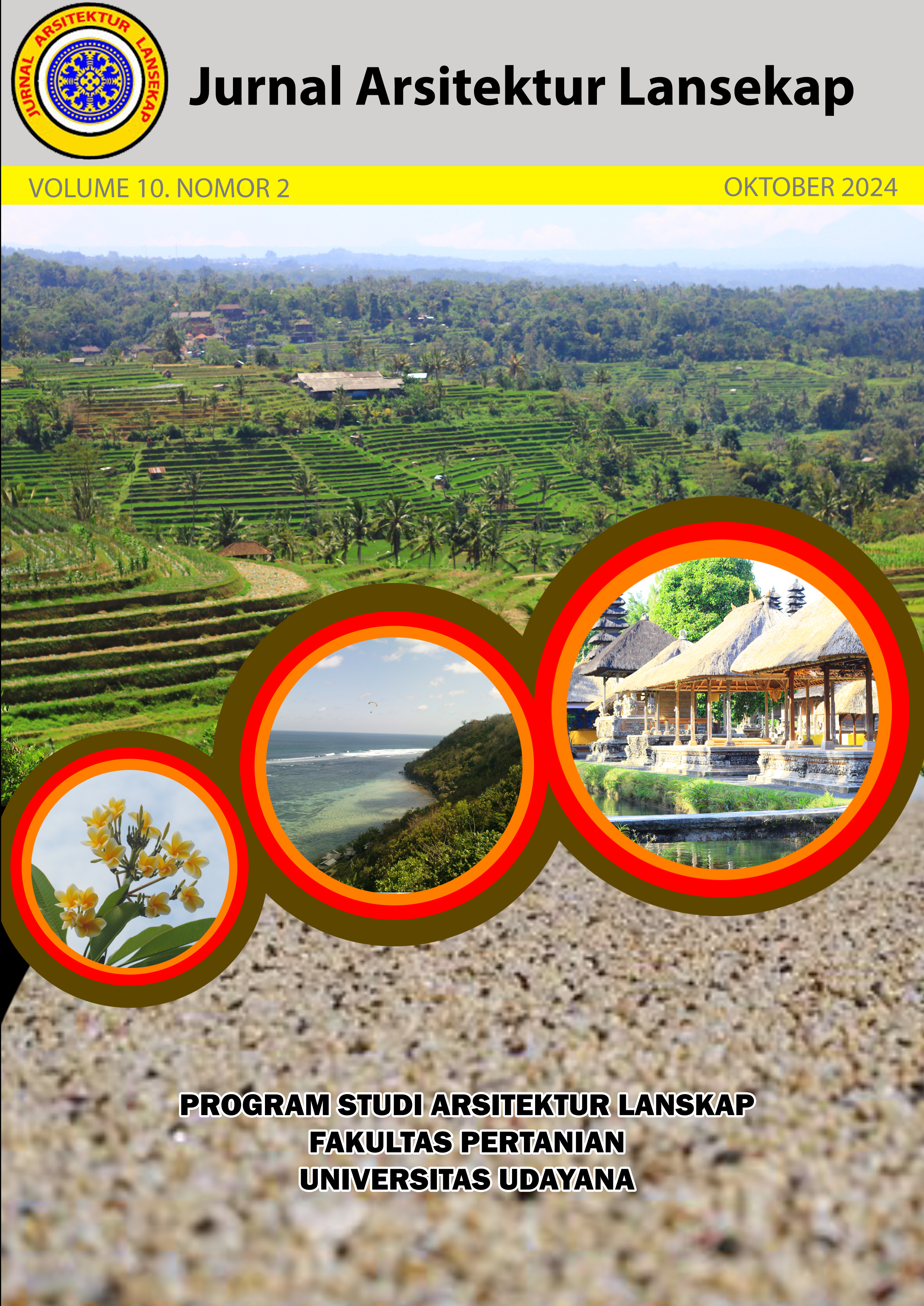Identifikasi Karakteristik Budaya Banyuwangi sebagai Alternatif Ikon Kota di Taman Sritanjung
Abstract
Sritanjung Park is one of the city parks designed with the concept of a park as a green open space. The location of Sritanjung Park is in a very strategic location, namely in the middle of the city of Banyuwangi. This study aims to identify the typical culture of Banyuwangi that has the potential and can be used as a source of inspiration to characterize Sritanjung Park which describes the city of Banyuwangi. This research was conducted using an exploratory survey method. Data collection techniques through observation saw the condition of Sritanjung Park, interviews with community leaders, and literature studies from various sources of books, journals, and research reports related to Banyuwangi culture. The data collected were analyzed descriptively qualitatively. The results of the study explain that currently Sritanjung Park already has a character, namely gesah which means talking to each other, because the people of Banyuwangi are egalitarian (open). The story of the name Sritanjung should be the basis for planning Sritanjung Park, which is comfortable, safe and gives pride. Alternative recommendations for icons that emerged from this study were decorative lamps, batik motif chairs and barong kemiren motif chairs.
Downloads
References
Darusuprapta. 1987. Babad Blambangan Karya Kanjeng Raden Tumenggung Arya Natadiningrat Bupati Banyuwangi. UGM Press. Yogyakarta.
Imansari, N., dan Khadiyanta, P. 2015. Penyediaan Hutan Kota dan Taman Kota Sebagai Ruang Terbuka Hijau (RTH) Publik menurut Preferensi Masyarakat Di Kawasan Pusat Kota Tangerang. Ruang, Vol. 1 No. 3, 101-110.
Indiarti, W. 2016. Masa Lalu Masa Kini Banyuwangi: Identitas Kota dalam Geliat Hibriditas dan Komodifikasi Budaya di Perbatasan Timur Jawa. Fakultas Bahasa dan Seni Universitas PGRI Banyuwangi.
Banyuwangi
Indiarti, Wiwin dan Anasrullah. 2020. Lontar Sri Tanjung Kidung Kuno Ujung Timur Jawa. Dinas Perpustakaan dan Kearsipan Kabupaten Banyuwangi. Banyuwangi. ISBN: 978-623-95161-1-6
Jorgensen, Karsten (1998). Semiotics in Landscape Design, Landscape Review, Norway, 1, pp. 41-44
Maharani, Rizza. 2018. Kajian Lanskap Budaya Masyarakat Osing di Kabupaten Banyuwangi. Skripsi. Departemen Arsitektur Lanskap, Fakultas Pertanian, Institut Pertanian Bogor. Bogor.
Morissan. 2017. Metode Penelitian Survei. Kencana. Jakarta.
Pemerintah Kabupaten Banyuwangi. Gambaran Umum. Online at: https://www.banyuwangikab.go.id/profil/gambaranumum.html. Diakses pada tanggal 7 Mei 2019.
Peraturan Menteri Pekerjaan Umum Nomor 5/PRT/M/2008 tentang Pedoman Penyediaan dan Pemanfaatan Ruang Terbuka Hijau di Kawasan Perkotaan.
Pratiwi, Prihani. 2016. Makna Visual Relief Cerita Sri Tanjung Candi Penataran. Skripsi. Program Studi Seni Rupa Murni. Fakultas Seni Rupa dan Desain. Institut Seni Indonesia. Surakarta.
Saputri, Desy Dwi. 2018. Penilaian Fungsi Taman Kota Sebagai Ruang Terbuka Publik di Kota Surabaya. Jurnal Penataan Ruang, Vol. 13, No. 2. Surabaya.
Singodimayan, Hasnan, Hasan Basri., Antariksawan Jusuf. 2015. Enam Mata Tentang Banyuwangi. Pustaka Larasan. Denpasar.
Vidiyanti, M. Oktavia. 2016. Banterang Surati: Cerita Rakyat dari Jawa Timur. Badan Pengembangan dan
Pembinaan. Jakarta

This work is licensed under a Creative Commons Attribution-ShareAlike 4.0 International License.
An author who publishes in the Jurnal Arsitektur Lansekap (JAL) agrees to the following terms:
- Author retains the copyright and grants the journal the right of first publication of the work simultaneously licensed under the Creative Commons Attribution-ShareAlike 4.0 License that allows others to share the work with an acknowledgement of the work's authorship and initial publication in this journal
- Author is able to enter into separate, additional contractual arrangements for the non-exclusive distribution of the journal's published version of the work (e.g., post it to an institutional repository or publish it in a book) with the acknowledgement of its initial publication in this journal.
- Author is permitted and encouraged to post his/her work online (e.g., in institutional repositories or on their website) prior to and during the submission process, as it can lead to productive exchanges, as well as earlier and greater citation of the published work (See The Effect of Open Access).
Read more about the Creative Commons Attribution-ShareAlike 4.0 Licence here: https://creativecommons.org/licenses/by-sa/4.0/.







